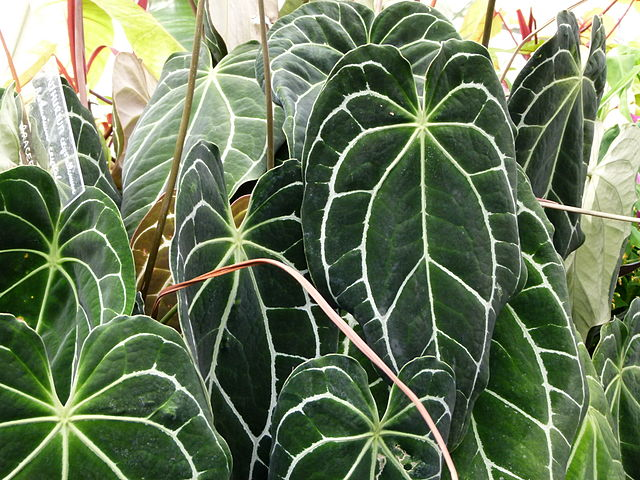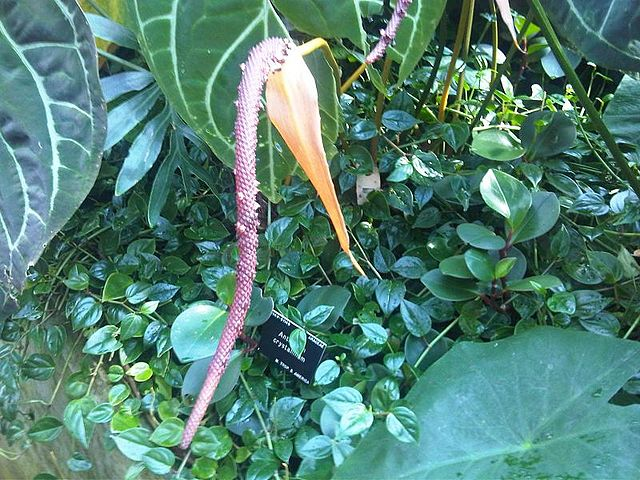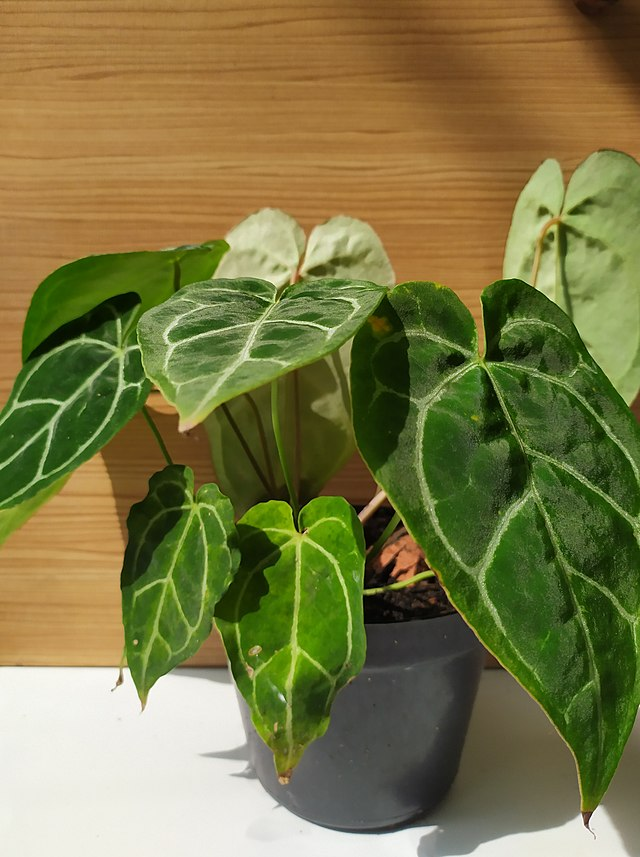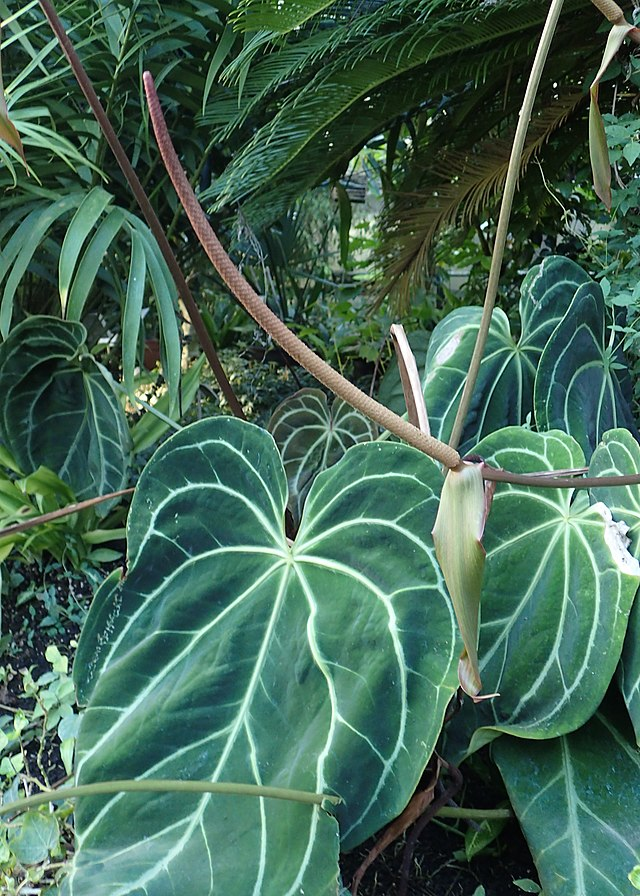Anthurium crystallinum is a velvety-leaved, heart-shaped evergreen plant with a very interesting and distinct venation pattern. These plants are common as outdoor plants in tropical areas, but they also make beautiful houseplants.
It thrives in above-average humidity, so when you plan to add this to your collection, it’s great to reproduce the natural habitat in which it lives, which are tropical rainforests.
Since this is a natural epiphyte, most of the nutrition for this Central American plant comes from the air, rain, and garbage surrounding it. This lovely Anthurium species is part of the Araceae family.

Anthurium crystallinum Profile
General Information
The Crystal Anthurium is a perennial tropical exotic plant that thrives in its natural home’s warm, humid, jungle-like environments.
Because of its heart-shaped, velvety leaves with striking white veins, it is a popular plant throughout Central and South America. Its leaves exist in a variety of colors; however, they are most typically green or dark purple.
Anthurium crystallinum can grow 90 cm in height and width up to 35 inches. The temperature should be regulated between 65 and 75 degrees Fahrenheit in humidified environments (18 and 24 degrees Celsius). When it comes to lighting, many plants love bright light.
Etymology
The genus Anthurium refers to the tail-like spadix of the members of this tropical group. Anthurium comes from the Greek words “anthos” and “oura,” which mean “flower” and “tail,” respectively. Large, frequently brilliantly colored leaves, a cylindrical spadix, and a colorful spathe characterize this arum family member.
On the other hand, the species name “crystallinum” refers to the gem-like glistening that can be observed on the leaf surfaces, especially on the veins, when hit by bright light.
Flowering

Anthurium crystallinum is an angiosperm, a flowering plant species. The flower has a lovely smell and a dull purplish-brown color of the spathe, the leaf-like structure. Since the flowers are unshowy, this plant is grown mainly for its leaves. However, if the plant is grown in tropical conditions, flowers can bloom at any time of year.
To guarantee that your Anthurium crystallinum plants will bloom, provide enough indirect sunlight as well as adequate watering.
In addition, you may use a diluted phosphorus-rich fertilizer or an excellent orchid fertilizer to help induce blooms. If your Anthurium does not bloom, it might be due to a nutritional deficiency.
RELATED: Philodendron gloriosum: The Fail-proof Care, Propagation, and Watering Guide You Need
Season Of Interest And Purchasing
The best time to plant this large-leafed plant is around April. However, its flowers can bloom throughout the year, from summer to winter. Anthuriums are popular as outdoor plants in tropical environments, but they also make excellent houseplants.
Anthurium crystallinum plants thrive in similar conditions to humans. They like heat, humidity, and plenty of dappled light, all of which are pretty similar to indoor circumstances, making them great houseplants. So start growing your Anthurium in rooms with the greatest humidity levels.
Growth
Crystal Anthuriums are slow-growing garden plants, especially in low-light conditions. It may take two to five years for this plant to reach maturity.
In its environment, the leaves are medium-sized and can grow to a maximum of 12 inches. They are quite small and suitable for indoors. When grown outdoors, Anthurium crystallinum leaves can grow to be 24′′–30′′ long.
Anthurium Crystallinum Overview
| Scientific name | Anthurium crystallinum |
| Common name/s | Crystal Anthurium |
| Family | Araceae |
| Growth Habit | Herbaceous |
| Height and Spread | up to 24-30 inches tall, leaves spread to 12 inches |
| Classification based on life cycle | Perennial |
| Origin and Distribution | Native to Central and South America |
| Climate Zone | Generally mild climate |
| USDA Plant Hardiness Zone | USDA Zone 10-12 |
| Color | Velvety evergreen with gem-like glistening on the leaf surfaces and white to cream-colored veins |
RELATED: Alocasia Black Velvet: An Instructive Care, Propagation, and Watering Guide
Care Tips
Light Requirement
Anthurium crystallinum requires 70-85 percent of its daily energy from sunlight. In other words, it has to be exposed to bright light on a regular basis in order to flourish properly.
Grow lights are an important aspect of the Anthurium crystallinum requirements. The Crystal Anthurium plant grows extremely slowly in low light conditions.
The best light condition for the Anthurium is bright indirect light. Direct light is a no-no because it will burn the leaves.
Temperature Requirement
Anthurium crystallinum thrives in humid areas and requires 65 to 75 degrees Fahrenheit temperatures to grow well. Therefore, it prefers temperatures that are somewhat warm. However, they are not resistant to extremely high temperatures.
Excessively high or low temperatures and constantly fluctuating temperatures create hindrances to their growth. If you live in the northern hemisphere, you may need to bring the plant inside during the winter.
Humidity Requirement
Anthurium crystallinum plants are used to high humidity levels in tropical areas since they are constantly exposed to moisture. High humidity levels of 70% to 80% are ideal for the development of Anthurium crystallinum.
Maintain high humidity for your plant, whether indoors or outside. Some tips for you are that you can grow your Anthurium crystallinum in a bathroom if you have well-lit windows. Lack of humidity leads to curling, wilting, discoloration, and falling of your plant’s leaves.
Soil Requirement
The Crystal Anthurium is an epiphytic plant, which is its most identifiable feature. It may be found growing on tree trunks, hill slopes, and any other wet surface.
As a result, its dynamic habitat does not need a specific soil type. However, Anthurium requires well-drained soil that retains moisture well, especially if grown in a warm climate.
To help your houseplant thrive, it is ideal to cultivate them in a soil that is well-draining, bright, porous, and nutrient-rich. Use dried sterile garden compost to make your own Anthurium crystallinum soil.
You can add peat moss, sphagnum moss, pine bark, orchid bark, and coconut coir to your soil mixture in order to healthily grow Anthurium crystallinum.
Fertilizer Requirement
The secret to healthy, lush green plants is proper fertilizer. Your Crystal Anthurium has specific nutritional requirements for optimal development like any other houseplant.
Anthurium crystallinum maintenance requires little more than a once-a-month application of a properly balanced slow releas fertilizer in boosting and improving growth.
Organic fertilizers are better than chemical fertilizers for epiphytes like Anthurium since these are slow-releasing.
Fertilize your Anthurium crystallinum once a month throughout the growing season. Lack of fertilization causes stunted development, limping, and drooping of leaves, among other issues.
Space Requirement
Anthurium crystallinum does not require a lot of space to thrive. Place your plant in a bright spot but not in direct sunlight for best results. Plant anthurium crystals in the container with the thick root mixture. The ideal pot size for this plant is 8–10 inches.
Growing And Planting Tips

Propagation
It is quite simple, even for beginners, to propagate Anthurium crystallinum; however, the results can be somewhat variable.
- To propagate Anthurium crystallinum via Root division
Simply separating two or more Anthurium crystallinum plants growing in the same container is an easy approach to reproduce Anthurium crystallinum. This is a reliable procedure, but only if your plant is firm and developed.
- To propagate Anthurium crystallinum through plantlets
Young plantlets can occasionally be seen near the roots of adult plants. From the bottom, they are attached to the stem. Just as with root division, you can split the plantlets at the start of the growing season. Only if your Anthurium crystallinum has outgrown it would I suggest it.
- To propagate Anthurium crystallinum through seed
This is the slowest and most challenging way of propagation. To obtain the seeds, the plant must first produce a flower, then a fruit from which the seeds can be extracted. Once you wash the pulp, the process is the same as with division.
However, since you are starting from the seed, your Crystallinum will probably be able to adapt better to any imperfect growing conditions. Still, please keep it in a warm, high humidity area for best results.
Pruning
Pruning is not necessary for crystal anthuriums, although it is a crucial care aspect for Anthurium crystallinum’s good growth. Trim away any damage like brown and yellow or dead leaves. It promotes new development and prevents the plant from wasting energy on exhausted, damaged, or dead portions.
Potting And Repotting
Potting your Crystal Anthurium is a simple process. First, fill the new container with fresh potting soil. Next, layer organic debris in a tiny pot, then insert the plant in the pot and pour the chunky mixture surrounding the roots.
Repot your Anthurium crystallinum only when roots begin to fill the pot and suffocate the soil. Repotting can be improved by adding organic material to the soil and using balanced, well-diluted feeders. Then, every two years, at the beginning of spring, repot.
Anthurium Crystallinum Care
| Light | Bright indirect light |
| Temperature | Intermediate to warm, 65-75 degrees Fahrenheit |
| Water | Once a week, increased in summer, decreased in winter |
| Soil | Airy, well-draining soil, bright, porous |
| Fertilization | Regular household fertilizer, once a month |
| Space | Plenty of space to creep or climb |
| Propagation | Via root division, plantlets, and seeds |
| Blooming | With proper conditions, it can bloom anytime of the year |
| Pruning | Not necessary |
| Potting | Regular potting mix, use of perlite and coco coir |
Problems And Troubleshooting
Overwatering
Overwatering your Anthurium will cause poor soil aeration, which can cause root rot and poor water absorption. If your plant suddenly begins to yellow and wilt, you should check its roots.
The fungal infection Pythium produces leaf yellowing and withering, which spreads caused by the waterlogged soil. Adequate irrigation is probably the most critical aspect of every plant species’ development.
Underwatering
Watering your plant is recommended to always be done with caution because they are prone to both underwatering and overwatering. If your leaves are completely yellow with some brown areas, your plant suffers from a lengthy drought. Underwatered leaves are crispy and dry. It also promotes curling, stunted development, and leaf drooping.
Nutrient Deficiency
Nutritional deficiencies reduce photosynthesis and stress the plant. Yellowing or brown leaves are often signs that a plant’s environment is insufficient in humidity or inadequately hydrated, which affects how efficiently the roots absorb nutrients. Maintaining the right conditions and making sure the soil mix is permeable enough will help you prevent difficulties.
Flowering Problems
In low light, anthuriums will slow their blooming development. On the other hand, small blooms might be created by too much light. When this plant is repeatedly starved of water, it produces few or deformed flowers.
To guarantee to flower, feed your Anthurium crystallinum with a diluted phosphorus-rich fertilizer or an excellent orchid fertilizer and provide plenty of indirect sunshine and water.
Anthurium crystallinum Pests And Diseases
| Common Pests/Diseases | Symptoms | Treatment and Prevention |
Common diseases include crown rot, stem rot, root rot, leaf spot, fungal diseases, and Xanthomonas infection | Yellowish rimming around black or dark brown spots on leaves | Avoid overwatering. Keep soil dry. Avoid too high humidity.Proper ventilation is needed around the plant. Remove infected parts of fungal infections to avoid spreading |
| Common pests include mealybugs, spider mites, aphids, and scales | Visible insects on the surface | Spray plant with warm, soapy water. If infestation is present, use insecticide or neem oil. Use diatomaceous earth. |
Problems With People And Animals
Toxicity
Like others in the Araceae family, this plant contains insoluble calcium oxalate crystals. It can irritate the mouth, digestive system, and throat if ingested. Because these crystals induce tissue penetration and irritation, they should be kept away from your pets and children.
These calcium oxalate crystals are what make Anthurium crystallinum toxic.
Anthurium Plants Meaning And Symbolism
Anthurium is a Greek word that means “tail flower,” and it is one of the best houseplants to have since it represents long-lasting love and friendship. It is a great gift for people close to your heart, may it be platonic or romantic.
Many people also keep this plant as a symbol of prosperity.
Anthurium Crystallinum Symbolism And Meaning
| General Meaning | long-lasting love and friendship |
| Symbolism | Prosperity |
Landscaping And Gardening Ideas

Companion Plants
Anthurium plants are quite attractive. They are classified as indoor plants since they prefer warmth and grow more quickly in home surroundings. Because of these, they are excellent companion plants.
Growing it with numerous houseplants in one pot is a terrific way to create an exciting and unique show in your home. Still, you’ll need other plants that enjoy the same soil density, lighting, watering, and humidity.
Choose some other tropical plants to put alongside your Anthurium for a stunning show. African Violet, Aglaonema, and even Bonsai are all ideal companion plants for Anthurium.
Some of the plants you may consider include bird of paradise, areca palms, fire spike, heliconia, variegated arboricola, croton, chenille plant, and pentas.
Some of these plants will have additional colors and hues of warm oranges and reds, which will perfectly complement your cool dark greens.
Landscaping Ideas
It would be best if you kept your Anthurium in a light, warm environment. It will thrive in bright indirect sunshine. Any room will suffice as long as it fits these requirements. If your bathroom receives enough light, this might be an excellent way to maintain the humidity levels high.
Another perfect option is a living room. Because anthuriums are so lovely, they should be on full show. When growing anthuriums outside, it is ideal to plant them in pots that can be transferred inside if temperatures in your area fall below 60 degrees.
Anthuriums go well as accents inside a humid room or a cozy deck or patio. A full plant can also be placed in the corner of the house or along the entryway.
Outdoors, it can be a filler plant for a garden corner, in between palm trunks, or under tall trees. It can also be placed near pools to add even more tropical vibes as long as it won’t get splashed at.
| What to plant with | Other Aroids, Bird of Paradise, Areca Palms, Fire Spike, Heliconia, Variegated Arboricola, Croton, Chenille Plant, Pentas, African Violets, Aglaonema, Bonsai Trees |
| What NOT to plant with | Basically nothing |
Conclusion

The Anthurium crystallinum, a plant native to Central and South America, is well-known for its heart-shaped leaves. It is a tropical evergreen with velvety-touching leaves. It may be grown in a variety of soils or with no soil at all. It thrives in its natural home’s warm, humid, jungle-like environments as a tropical plant. With proper Anthurium crystallinum care, it can start to flower within a year. Crystallinum is a favorite among houseplant enthusiasts since it is reasonably easy to care for.
Frequently Asked Questions (FAQS)
How long does Anthurium crystallinum take to grow?
Your Crystal Anthurium is a slow-growing plant. It could take 1-2 years for your plant to grow into maturity. New leaves also sprout at least once every four weeks, given the proper care and attention.
Is Anthurium crystallinum hard to care for?
The Crystal Anthurium is pretty easy and very straightforward to care for. They are plants that can be handled even by beginners. The key to a healthy Anthurium is to give them the proper light, water, fertilization, humidity, and of course, love!
Why is my Anthurium crystallinum drooping?
Drooping leaves of your Anthurium crystallinum could be due to several reasons. For example, it could be due to improper watering frequency, nutrient deficiency, or environmental problems such as inappropriate lighting conditions, humidity, and soil type. Observe your care to know the root cause of your problem.
How do you make Anthurium crystallinum grow faster?
Your Crystal Anthurium is a slow-growing plant by nature. It takes 1-2 years for this plant to grow into maturity. However, a new leaf can sprout every four weeks under proper conditions.
Do you have other tips on how to take care of Anthurium crystallinum? Share it with us below. Also, check out our other articles:
12 Unique Asparagus Flowers (Including Pictures)
5 Breath-taking Types Of Calathea For Your Private Tropic Corner
11 Outdoor Foliage Plants To Arrange Your Garden Like A Professional Landscape Designer







